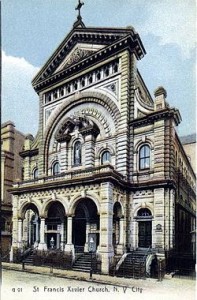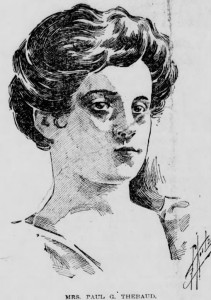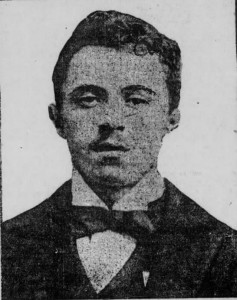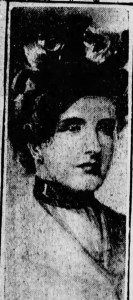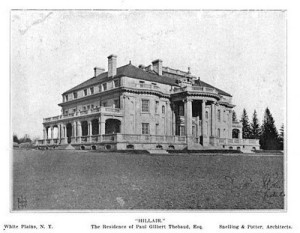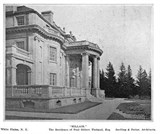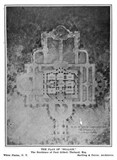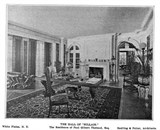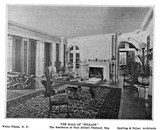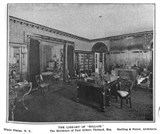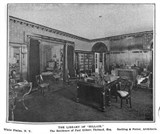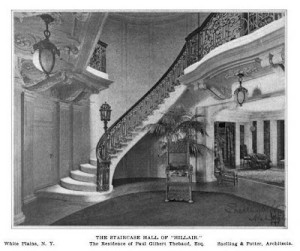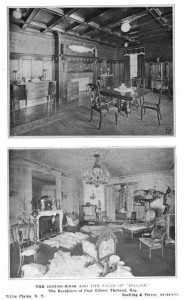The Thebaud family is distantly related to the Alexandres. The wealthy Catholic families of New York tended to intermarry, just as the Quaker families did. Paul Gibert Thebaud Sr. (1866-1925) was the husband of sister-in-law of the great grandmother of my wife. Paul Sr. married Mathilde Eugenie Reynal on June 16, 1889 in St. Francis Xavier. It was a spectacle:
The white marble altar was covered with candles; twenty priests in rich vestments and a hundred choristers thronged the chancel; the Archbishop [Corrigan] in vestments of white and gold and wearing his jeweled mitre, performed the ceremony, while the bridal procession, composed of twelve ushers, twenty bridesmaids, and the bride, leaning on her father’s arm, swept up the broad centre aisle to the superb wedding march from Lohengrin, rendered by a full string orchestra with organ accompaniment.
The bride’s dowry was $1,000,000 ($26,000,000 in 2015 dollars) and she also received 300 presents from the 3,000 guests:, including a complete dinner service in gold and silver.
Mathilde was the sister of Nathaniel Reynal, the second husband of Sarah Caldwell (my wife is descended from her first husband, Nathaniel Rutter), and that is one way my wife is related to the Reynals, about whom much will be said in later blogs.
A distant relationship, but the families kept up contact, and a Mrs. Thebaud was the godmother of my wife’s uncle Teddy. When, as a child, he received a present from her, he asked his mother, “Who is ‘the bawd?’”
Paul Sr. was a commission merchant with the firm Paul G. and Paul L. Thebaud, which had been founded as Bouchard, Thebaud and Co. in 1789. Paul Sr. did well for himself. A taste for big houses runs through all the family He had a town house on Madison Avenue, and decided to build a mansion in White Plains. While he was building it he stayed in White Plains, with friends, the Howard Willets.
There a crime, which sounds like it had been plotted by P.G. Woodhouse, affected the tranquility of the Thebauds.
Mr. and Mrs. Edward Kern, Sr., a Swiss couple, worked for the Thebauds. Their son, Edward Jr. was visting them and caught Mr. Thebaud’s eye. Edward was hired as Thebaud’s valet. The elder Kern had spent a year in the Tombs in 1895-1896 for swindling. Kern was also a small time crook. He had been convicted of forgery in Switzerland and under the name of Emil Brown he served a year for forgery. All of this was of course unknown to the Thebauds.
Edward Kern, Jr.
Marie Pollion
Kern had met the wife of a French waiter, the lovely Madame Marie Pollion, in Switzerland in 1896.
They both ended up in New York, and resumed the affair. But he needed some cash to finance the escapade. After working a few weeks at the Thebauds, he knew that Mrs. Thebaud had a fortune in jewels.
On Saturday December 28, 1901, the Thebauds went to visit Willets in White Plains. Kern accompanied them, but returned to the city on the pretense of having forgotten the razors. He emptied the strongbox, which contained mostly stickpins (275 of them), but did not find the main jewels.
Kern put the jewels in a satchel, caught the 11:30 PM train to White Plains and fell asleep. Mr. Thebaud was also in town and boarded the same train and got into the same car. He saw Kern asleep with a satchel at his feet. Thebaud thought he should teach Kern a lesson about being careless, so he had a trainman hide the satchel. When Kern woke up, he explained to Thebaud that he had forgotten the razors and had returned to get them. He was horrified to discover the satchel missing. Thebaud gave him a reproof and handled the satchel back to Kern – the satchel, Thebaud later realized that contained his stolen stickpins.
Kern then took the other jewels, a pear-shaped diamond (worth $20,000 then, $500,000 in 2015 dollars) and a pearl ($15,000 then, $350,000 in 2015 dollars). On Sunday morning he feigned illness and was allowed to take the Willets’ horse and buggy to the station to get a train to see a doctor.
The Thebauds and the Willets went to mass. By the afternoon Kern had not returned, and Mrs. Thebaud looked for her jewels, and discovered her diamond and pearls were missing although a brooch valued at $50,000 ($1,500,000 in 2015 dollars) was still there. She called the Madison Avenue townhouse, and the housekeeper discovered that the strong box was empty and the jewels gone.
The Thebauds called the police. A disconsolate Mr. Edward Pollion also came to the police. His neighbors had told him that his wife had run away with a young man, a valet , who had been a frequent visitor when Mr. Pollion was not home. Mrs. Pollion had not known (she later claimed) about the theft, but she agreed to go to a pawnshop with Kern and claim the jewels were hers. They got $700, all the cash the pawnbroker had on Sunday, on jewels valued at 30,000 and planned to escape to Switzerland. The police tracked and arrested Mrs. Pollion as she was biding farewell to friends. She had both her and Kern’s clothes with her. The pawnbroker, as soon as he had seen the account of the robbery, had called the police, police went to the pawnshop and recovered most of the the jewels that had been stolen.
The police identified Mrs. Pollion, Edward Kern, Sr. and Edward Kern, Jr. from the Rogues Gallery.
Kern met two fellow criminal, one of whom had met him at a race track and recognized him as the thief of the Thebaud jewels. Kern pled for silence and promised to split the loot. They traveled under assumed names, Theodore Manners (Kern), A. P. Howe, and P. Mars.
The three checked into a hotel in New Orleans. When Kern/Manners was out one evening, the other two asked that their trunks be brought down and checked out of the hotel. They later said they planned to have Kern file a claim for stolen property and get money from the hotel, but they either did not inform Kern of this plan or he forgot it – or, of course, they were lying. They went to two train stations to try to get a train out of town, but they were too late. They rowed a skiff across the Mississippi to Gretna and waited to catch the first morning train.
Meanwhile Manners-Kern returned to the hotel and discovered his fellow crooks and the loot gone. He reported the theft to the police. The police searched for the thieves, and a newsboy in Gretna reported two men were acting suspiciously. The police arrived and arrested them and informed Manners-Kern that he could come to reclaim his possessions. He was reluctant.
When he confronted the other two, one said “You have turned us in, you scoundrel.” He told the police: “This is Edward Kern, valet and thief, who robbed Paul Thebaud in New York.” The police looked in the valise and found $2,500 of jewelry which matched the description of the Thebaud jewels. Kern insisted he was Theodore Manners from Chicago.
Paul Thebaud and one of New York’s finest, Detective Kelly, arrived in Gretna to identify Kern and reclaim the jewels. Rumor had gotten around that Thebaud had offered a $10,000 reward for the jewels, but this was only a rumor. The sheriff refused to release Kern until Thebaud forked over the $10,000, and Thebaud refused to do that, because he had never promised it. Negotiations followed, and Thebaud made a gift of $250 to the Gretna police department.
Thebaud returned to New York, and Kelly and Kern were waiting in the train station to get the through train when Kelly spotted two pickpockets whom he knew, and lit off after them. He collared one immediately, and chased the other for half a mile before he collared him.
Kern pleaded guilty in April 1902 and got four and a half years in Sing Sing. The comrades who had gone off with his trunk were charged with theft, on the principle that thief one had priority over thief two. In June 1902 Kern tried to get them off by claiming that he had instructed them to take the trunk out of his room and meet him in Atlanta, where they were to divide the spoils or return his property. The judge was not impressed, and sentenced the two to three years of hard labor. After early release from Sing Sing, Kern resumed a spectacular career of con artistry , made the mistake of antagonizing William Randolph Hearst, and died in a hotel room after taking cyanide.
To add to the Thebauds’ troubles, at the same time the robbery was occurring the house that they were building caught fire and was totally destroyed. But Thebaud went ahead with new plans and built Hillair, which was completed in 1904.
The Architectural Record had an extended description of Hillair:
The house itself, facing south, is seen a distance of several miles away, and is a fairly true example of Georgian architecture. The plan being symmetrical, a necessity in this style, it has the usual porch, but on the rear or south front, and not at the entrance which is on the north. The material from which “Hillair” is built is Indiana limestone of the gray variety the surface of the walls being of coursed ashlar. The original design shows a house of brick, with the same limestone trim, cornice and columns as now exist. The change to stone enhances the general good appearance, and is in fact more in keeping with the design. The semi- hexagonal “porte-cochere” on the north is a reasonable departure from the Georgian period, and is distinctly eclectic in character, but entirely reasonable in its purpose and form. The classical character of the period is well exhibited in the entablature and columns of the Ionic order, on every side of the house. The owner insisted on a veranda surrounding the entire plan etc. etc. etc.
All was not well in the Thebaud establishment. The firm failed in 1907 because of the failure of a corresponding firm in Central America, although the Thebauds’ personal fortune was not affected.
In 1907 another catastrophe hit the family, one which I will cover in the blog about Paul Gilbert Thebaud Jr.
Mr. and Mrs. Thebaud separated in 1911, and he gave her the house and $20,000,000 ($500,000,000 in 2013 dollars). He died in 1925.
